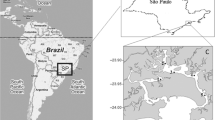Abstract
Fertilization with a mixture of steelmaking slag and compost can affect the supply of dissolved iron used to restore seaweed beds, however, the mechanisms of iron elution from the fertilizer are not well understood. In the present study, the microorganism was isolated from Fe-fertilizer incubated in coastal seawater for 6 months, and was identified as Exiguobacterium oxidotolerans by 16S rDNA sequencing. The iron elutability of the bacteria was proved based on the increasing of dissolved iron by incubation with Fe2O3 (hematite) under a seawater-like condition. The value of ORP was changed by inoculated of the bacteria from ca. 0 to ca. -400 mV, which is anticipated concerning to reduction of Fe. The concentration of eluted iron was largely depended on those of organic acids produced by bacteria. From the results, it was proved that E. oxidotolerans is capable of Fe reductive eluting of iron from Fe2O3 into seawater. Anthraquinone-2,7- disulfonate (AQDS), which can play as an electron acceptor/donor between microbe and insoluble Fe2O3 particles, enhanced the effect of iron bio-leaching.
Similar content being viewed by others
References
K. Matsunaga, T. Kawaguchi, Y. Suzuki, and G. Nigi, J. Exp. Mar. Biol. Ecol., 1999, 241, 193.
T. Motomura and Y. Sakai, Jpn. J. Phycol., 1984, 32, 209.
K. Suzuki, K. Kuma, I. Kudo, and K. Matsunaga, Phycologia, 1995, 34, 201.
H. Iwai, M. Fukushima, T. Motomura, T. Kato, and C. Kosugi, J. Appl. Phycol., 2015, 27, 1583.
M. Boye, C. M. G. Van der Berg, J. T. M. de Jong, H. Leach, P. Croot, and H. J. W. de Baar, Deep Sea Res. Part I Oceanogr. Res. Pap., 2001, 48, 1477.
D. Fujita, Fisheries Engineering, 2002, 39, 41.
A. L. Rose and T. D. Waite, Geochim. Cosmochim. Acta, 2006, 70, 3869.
M. Yamamoto, M. Fukushima, E. Kiso, T. Kato, M. Shibuya, S. Horiya, A. Nishida, K. Otsuka, and T. Komai, J. Chem. Eng. Jpn., 2010, 43, 627.
M. Yamamoto, A. Nishida, K. Otsuka, T. Komai, and M. Fukushima, Bioresource Technol., 2010, 101, 4456.
N. Fujisawa, M. Fukushima, M. Yamamoto, H. Iwai, T. Komai, Y. Kawabe and D. Liu, J. Anal. Appl. Pyrolysis, 2012, 95, 126.
H. Iwai, Y. Takasaki, and M. Fukushima, Anal. Sci., 2018, 34, 465.
K. H. Nealson and D. Saffarini, Annu. Rev. Microbiol., 1994, 48, 311.
L. Castro, C. Garcia-Balboa, F. Gonzalez, A. Ballester, M. L. Blazquez, and J. A. Munoz, Hydrometallurgy, 2013, 131-132, 29.
G. Qi, D. Yue, M. Fukushima, S. Fukushima, R. Nishimoto, and Y. Nie, Bioresources Technol., 2012, 114, 637.
R. Nishimoto, S. Fukuchi, S. Qi, M. Fukushima, and T. Sato, Colloids, Surf. A, 2013, 418, 117.
M. Fukushima and K. Tatsumi, Colloids, Surf. A, 1999, 155, 249.
J. Lian, Z. Hu, Z. Li, J. Guo, Z. Xu, Y. Guo, M. Li, and J. Yang, Biotechnol. Biotec. Eq., 2016, 30, 292.
K. Nakayasu, M. Fukushima, K. Sasaki, S. Tanaka, and H. Nakamura, Environ. Toxicol. Chem., 1999, 18, 1085.
R. P. Schwarzenbach, A. Werner, H. Christof, H. Stephan, and K. Jorg, China International Journal for Chemistry, 1997, 51, 908.
H. Iwai, M. Fukushima, and M. Yamamoto, Anal. Sci., 2013, 29, 723.
S. Bose, M. F. Hochella Jr., Y. A. Gorby, D. W. Kennedy, D. E. AcCready, D. S. Madden, and D. H. Lower, Geochim. Cosmochim. Acta, 2009, 73, 962.
M. Fukushima, K. Yamamoto, O. Ohtsuka, T. Aramaki, T. Komai, S. Ueda, and S. Horiya, Bioresour Technol., 2009, 100, 791.
E. A. Ghazy, M. G. Mahmoud, M. S. Asker, M. N. Mahmoud, M. M. Abo Elsoud, and M. E. Abdel S. Ami, Journal of American Science, 2011, 7, 604.
B. Stilinovic and J. Hrenovic, Acta. Bot. Croat., 2009, 68, 57.
D. W. King, Anal. Chim. Acta, 1991, 247, 125.
A. P. Grosvenor, B. A. Kobe, M. C. Biesinger, and N. S. McInyre, Surf. Interface Anal., 2004, 36, 1564.
I. Yumoto, M. Hishinuma-Narisawa, K. Hirota, T. Shingyo, F. Takebe, Y. Nodasaka, H. Matsuyama, and I. Hara, Int. J. Syst. Evol. Microbiol., 2004, 54, 2013.
Y. K. Lee, K. C. Sung, J. H. Yim, K. J. Park, H. Chung, and H. K. Lee, Ocean Polar Res., 2005, 27, 215.
C. Pesciaroli, F. Cupini, L. Selbmann, P. Barghini, and M. Fenice, Polar Biol., 2012, 35, 435.
E. E. Roden and D. R. Lovley, Appl. Environ. Microbiol., 1993, 59, 734.
H. W. Doelle, “Microbial Process Development”, 1994, World Scientific Publishing Company, Singapore.
J. W. Stucki and J. E. Kostka, CR Geosci., 2006, 338, 468.
T. Kamura, Y. Takai, and K. Ishikawa, Soil Sci. Plant Nutr., 1963, 9, 5.
D. K. Newman and R. Kolter, Nature, 2000, 405, 94.
Acknowledgments
This research was supported by JSPS KAKENHI grant Numbers 24686100 and 16H02985.
Author information
Authors and Affiliations
Corresponding author
Rights and permissions
About this article
Cite this article
Aneksampant, A., Tanaka, A., Tu, X. et al. Roles of Microbial Activity and Anthraquinone-2,7-disulfonate as a Model of Humic Substances in Leaching of Iron from Hematite into Seawater. ANAL. SCI. 34, 1303–1308 (2018). https://doi.org/10.2116/analsci.18P147
Received:
Accepted:
Published:
Issue Date:
DOI: https://doi.org/10.2116/analsci.18P147




